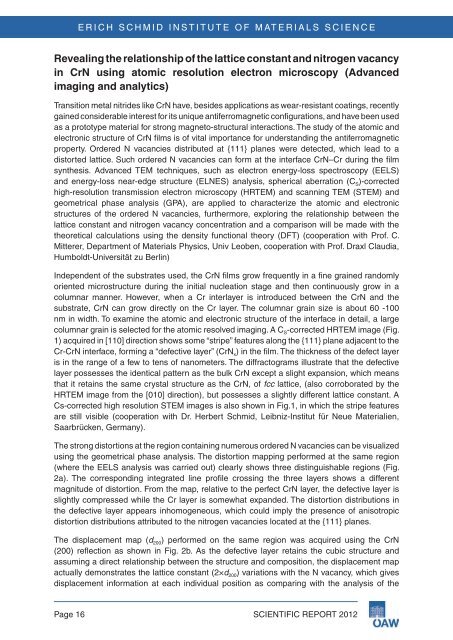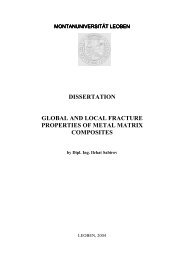Scientific Advisory Board - Erich Schmid Institute
Scientific Advisory Board - Erich Schmid Institute
Scientific Advisory Board - Erich Schmid Institute
Create successful ePaper yourself
Turn your PDF publications into a flip-book with our unique Google optimized e-Paper software.
ERICH SCHMID INSTITUTE OF MATERIALS SCIENCE<br />
Revealing the relationship of the lattice constant and nitrogen vacancy<br />
in CrN using atomic resolution electron microscopy (Advanced<br />
imaging and analytics)<br />
transition metal nitrides like crn have, besides applications as wear-resistant coatings, recently<br />
gained considerable interest for its unique antiferromagnetic configurations, and have been used<br />
as a prototype material for strong magneto-structural interactions. the study of the atomic and<br />
electronic structure of crn films is of vital importance for understanding the antiferromagnetic<br />
property. ordered n vacancies distributed at {111} planes were detected, which lead to a<br />
distorted lattice. Such ordered n vacancies can form at the interface crn–cr during the film<br />
synthesis. Advanced tem techniques, such as electron energy-loss spectroscopy (eeLS)<br />
and energy-loss near-edge structure (eLneS) analysis, spherical aberration (c S)-corrected<br />
high-resolution transmission electron microscopy (HRtem) and scanning tem (Stem) and<br />
geometrical phase analysis (gpA), are applied to characterize the atomic and electronic<br />
structures of the ordered n vacancies, furthermore, exploring the relationship between the<br />
lattice constant and nitrogen vacancy concentration and a comparison will be made with the<br />
theoretical calculations using the density functional theory (dft) (cooperation with prof. c.<br />
mitterer, department of materials physics, Univ Leoben, cooperation with prof. draxl claudia,<br />
Humboldt-Universität zu Berlin)<br />
independent of the substrates used, the crn films grow frequently in a fine grained randomly<br />
oriented microstructure during the initial nucleation stage and then continuously grow in a<br />
columnar manner. However, when a cr interlayer is introduced between the crn and the<br />
substrate, crn can grow directly on the cr layer. the columnar grain size is about 60 -100<br />
nm in width. to examine the atomic and electronic structure of the interface in detail, a large<br />
columnar grain is selected for the atomic resolved imaging. A c S-corrected HRtem image (fig.<br />
1) acquired in [110] direction shows some “stripe” features along the {111} plane adjacent to the<br />
cr-crn interface, forming a “defective layer” (crn x) in the film. the thickness of the defect layer<br />
is in the range of a few to tens of nanometers. the diffractograms illustrate that the defective<br />
layer possesses the identical pattern as the bulk crn except a slight expansion, which means<br />
that it retains the same crystal structure as the crn, of fcc lattice, (also corroborated by the<br />
HRtem image from the [010] direction), but possesses a slightly different lattice constant. A<br />
cs-corrected high resolution Stem images is also shown in fig.1, in which the stripe features<br />
are still visible (cooperation with dr. Herbert <strong>Schmid</strong>, Leibniz-institut für neue materialien,<br />
Saarbrücken, germany).<br />
the strong distortions at the region containing numerous ordered n vacancies can be visualized<br />
using the geometrical phase analysis. the distortion mapping performed at the same region<br />
(where the eeLS analysis was carried out) clearly shows three distinguishable regions (fig.<br />
2a). the corresponding integrated line profile crossing the three layers shows a different<br />
magnitude of distortion. from the map, relative to the perfect crn layer, the defective layer is<br />
slightly compressed while the cr layer is somewhat expanded. the distortion distributions in<br />
the defective layer appears inhomogeneous, which could imply the presence of anisotropic<br />
distortion distributions attributed to the nitrogen vacancies located at the {111} planes.<br />
the displacement map (d 200) performed on the same region was acquired using the crn<br />
(200) reflection as shown in fig. 2b. As the defective layer retains the cubic structure and<br />
assuming a direct relationship between the structure and composition, the displacement map<br />
actually demonstrates the lattice constant (2×d 200) variations with the n vacancy, which gives<br />
displacement information at each individual position as comparing with the analysis of the<br />
page 16 <strong>Scientific</strong> RepoRt 2012

















